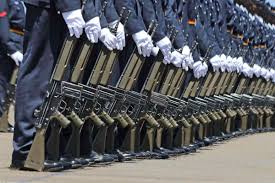Kenya is taking a decisive and visionary step to reassert its leadership in regional security with the planned recruitment of 10,000 police officers in the 2025–2026 financial year. This unprecedented move, announced by Interior and National Administration Cabinet Secretary Kipchumba Murkomen, is not only a response to immediate security concerns but also a bold investment in Kenya’s long-term stability, regional influence, and economic growth.
For years, overstretched police forces have struggled to meet the rising demands of modern security threats across Kenya’s diverse regions. From urban crime spikes to banditry in frontier counties, and the rising threats of violent extremism near porous borders, the limited capacity of the National Police Service has become a growing concern for citizens and government alike. Murkomen’s commitment to reinvigorating the security sector through large-scale recruitment, improved logistics, and enhanced officer welfare is a game-changer.
The short-term implications of this strategic recruitment initiative are immediate and profound. With an additional 10,000 officers deployed across the country, especially in high-risk and underserved regions such as Kilifi, Kwale, and Mombasa, the State will be able to significantly improve policing capacity and rapid response mechanisms. The addition of 5,000 vehicles for both the police and the National Government Administrative Officers (NGAO) further strengthens operational reach, mobility, and coordination across Kenya’s vast and often rugged terrain.
This manpower expansion also addresses a persistent and dangerous gap: the absence of adequate staffing in police stations, particularly in rural and high-crime areas. By filling these gaps, the government is reinforcing the frontline of national security, deterring criminal gangs, curbing cross-border threats, and ensuring that officers can enforce law and order without burnout or prolonged stationing, which has historically impeded performance and morale.
But this move goes far beyond meeting short-term security needs. In the long-term, it positions Kenya as the regional nucleus of stability and a beacon of progressive security sector reform in East Africa. The implications for regional security cooperation, border control, and transnational crime prevention are immense. As Kenya becomes better equipped and more agile in its security operations, neighboring countries stand to benefit from a ripple effect of enhanced coordination, intelligence sharing, and a stronger deterrence posture against terrorism, trafficking, and organized crime networks.
At a time when the global investment community is increasingly focused on stability and governance as key metrics for evaluating African markets, this development sends a resounding message: Kenya is serious about its security. Investors, both domestic and international, will find in Kenya a stable environment where rule of law is enforced, where economic activity is safeguarded, and where government institutions demonstrate both foresight and commitment to sustainable growth.
Moreover, Murkomen’s emphasis on enhancing the welfare and morale of police officers through housing support, a contributory benevolent fund, and decentralization of services signals a paradigm shift in how Kenya views its security personnel—not merely as enforcers, but as vital partners in national development. This people-centric approach will attract disciplined and qualified recruits while retaining experienced personnel who are integral to specialized operations, especially in border regions.
In calling upon development partners and the private sector to support this vision, the government is also creating space for innovative public-private partnerships that can transform the future of community policing, technology integration, and national resilience.
Kenya’s 10,000-officer recruitment drive is not just an act of resourcing the police; it is a landmark declaration of intent. It is a forward-leaning strategy that addresses the roots of insecurity, elevates institutional effectiveness, and asserts Kenya’s role as the leading security anchor of East Africa. The dividends of this initiative will be felt not just within Kenya’s borders but across the region, establishing a safer, more prosperous, and more secure East Africa.
Kenya has proposed an allocation of Sh16.5 billion to extend the Standard Gauge Railway (SGR) from Naivasha to the Malaba border, marking a pivotal step in the country's...
Read moreDetails









